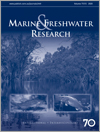Marine and Freshwater Research
Volume 71
Number 11 2020
This paper contains ecological knowledge collated to support the restoration of native freshwater fishes with a range of life-history strategies and values from Australia’s Murray–Darling Basin. This knowledge, together with examples and case studies illustrating its application to effective management, is presented to be valuable to both scientists and managers.
Native fishes of Australia’s Murray–Darling Basin have suffered significant population declines (>90%) over the past 150 years. Almost half the species are now of conservation concern, and there is an urgent need for remediation. The science is well established, and some robust restoration-enabling policies have been initiated. This paper summarises the 30 priority actions required for successful recovery.
Wetland conservation has become a global focus. The wetland conservation system in China, including the wetland protected area network and wetland grading system, still faces problems, such as the lack of uniform regulations, weak law enforcement, multisector cross-management and overlapping protection networks, although government reform involving wetlands is advancing. Perfecting the conservation system will contribute to sustainable development of global wetland conservation.
This research focuses on two countries, Egypt and Kenya, along the Nile River. It analyses changing water patterns over the years and water stress patterns along the river through literature review and existing data about the river. The aim is to promote better policies and management moving forward based on an understanding of the current situation on the river.
Sharks and rays are an important resource for Indonesia, but there, management is challenging because of the paucity of data on fisheries them. This study shows that shark and ray landings in the Bali Strait include threatened species and are dominated by immature individuals, which is concerning for the sustainability of these populations and demonstrates the need for regionally adapted fisheries management measures.
Monitoring juvenile bull sharks along the Texas coast from 1975 to 2016 revealed sharks exhibited partitioning based on size, co-occurring most frequently with individuals from the same cohort or one age class removed. Proximity to sites of freshwater inflow played an important role, particularly habitats adjacent to rivers, which the smallest juveniles preferred and the largest juveniles avoided, with effects amplified in estuaries with high freshwater inflow.
Feeding habits of albacore tuna from the western Indian Ocean and adjacent Atlantic waters were studied using stomach content analysis. Albacore exhibited a flexible feeding strategy, from ram filter feeding on abundant schooling species to individual chasing of large-sized prey. Albacore preyed on over 170 taxa, but few dominant species prevailed and their importance remained unchanged over five decades. Across global oceans, albacore prey was represented by the same families, and even species, suggesting occupation of a similar trophic niche worldwide.
Freshwater eels (Anguilla spp.) have a complex catadromous life cycle, which coupled with difficulty separating species based on morphology, makes them complex targets for conservation. We evaluated DNA barcoding to delimit four African eel species: the method was found to be a reliable tool for identifying African eels to the species level, opening the door for future environmental DNA and metabarcoding studies.
Beach worms are a commonly used bait in recreational and commercial fisheries, but we do not know if they are all part of one big, interconnected population, or many separate populations that do not interact much. We conducted one of the first genomic analyses of marine worms to better understand how connected their populations are in Australia, and to inform management.
 , Scott M. Raymond, Ivor Stuart, Charles R. Todd
, Scott M. Raymond, Ivor Stuart, Charles R. Todd  , Stephen R. Balcombe, Brenton P. Zampatti, Heleena Bamford, Brett A. Ingram
, Stephen R. Balcombe, Brenton P. Zampatti, Heleena Bamford, Brett A. Ingram  , Christopher M. Bice, Kate Burndred, Gavin Butler, Lee Baumgartner, Pam Clunie, Iain Ellis, Jamin P. Forbes, Michael Hutchison, Wayne M. Koster
, Christopher M. Bice, Kate Burndred, Gavin Butler, Lee Baumgartner, Pam Clunie, Iain Ellis, Jamin P. Forbes, Michael Hutchison, Wayne M. Koster  , Mark Lintermans, Jarod P. Lyon, Martin Mallen-Cooper, Matthew McLellan, Luke Pearce, Jordi Ryall, Clayton Sharpe, Daniel J. Stoessel
, Mark Lintermans, Jarod P. Lyon, Martin Mallen-Cooper, Matthew McLellan, Luke Pearce, Jordi Ryall, Clayton Sharpe, Daniel J. Stoessel  , Jason D. Thiem, Zeb Tonkin, Anthony Townsend and Qifeng Ye
, Jason D. Thiem, Zeb Tonkin, Anthony Townsend and Qifeng Ye




